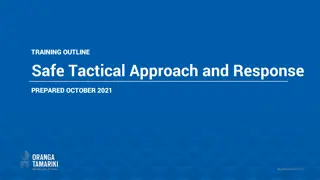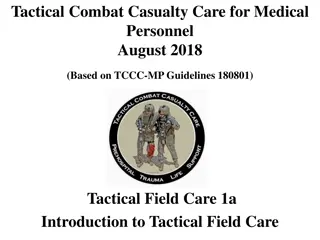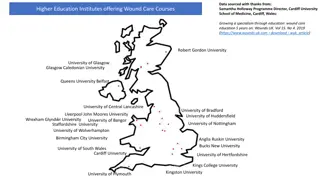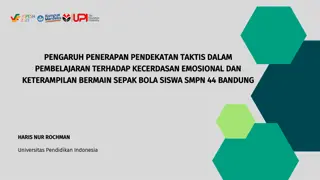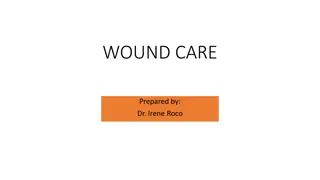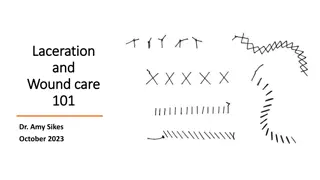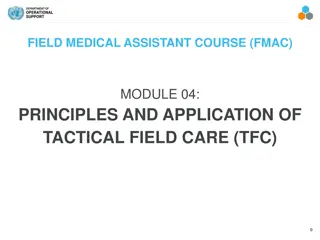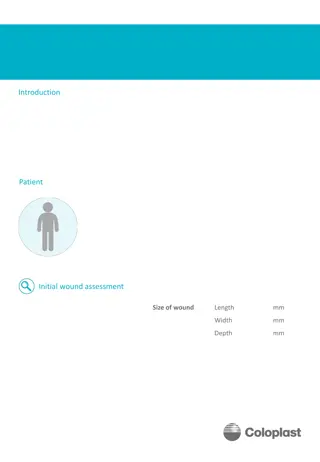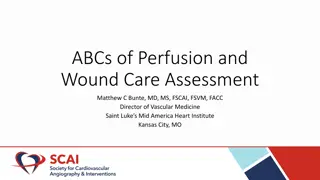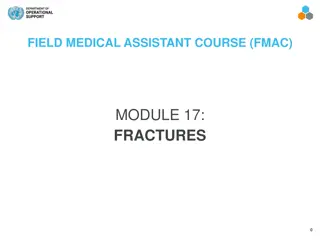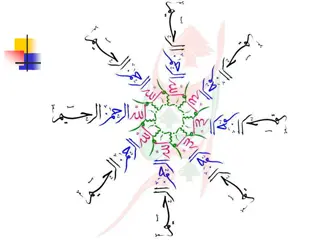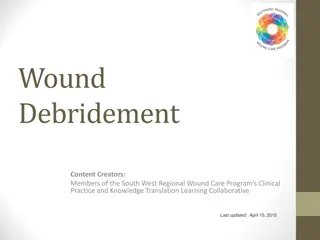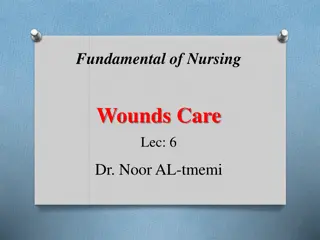Tactical Medicine Guidelines for Advanced Wound Care
Comprehensive guidelines on advanced wound care in tactical medicine, covering topics such as stopping bleeding early, resuscitation with blood products, tourniquet conversion, lessons learned from combat situations, early irrigation techniques, surgical debridement, and pre-surgical checklists. The content emphasizes the importance of quick and effective interventions to save lives and prevent complications in combat-related injuries.
Download Presentation

Please find below an Image/Link to download the presentation.
The content on the website is provided AS IS for your information and personal use only. It may not be sold, licensed, or shared on other websites without obtaining consent from the author.If you encounter any issues during the download, it is possible that the publisher has removed the file from their server.
You are allowed to download the files provided on this website for personal or commercial use, subject to the condition that they are used lawfully. All files are the property of their respective owners.
The content on the website is provided AS IS for your information and personal use only. It may not be sold, licensed, or shared on other websites without obtaining consent from the author.
E N D
Presentation Transcript
TCCC First 1.Stop Bleeding Early a.Tourniquets can be converted or reduced later b.Wound Packing 2.Resuscitate with warm fresh whole blood if possible 3.Early antibiotics buy time a.Ertapenam
Convert or Reduce Tourniquets to Save Tissue Jan 2016 Afghanistan 3rdSFG Team with National Gaurd Flight Medic SF Soldier single gunshot to lower extremity Tourniquet applied after signs of hemorrhagic shock MEDEVAC Helicopter stuck on objective Active firefight too hot for another pickup 19 hours until role 2
Lessons Learned From Marjah 1.Get tourniquets on early to prevent blood loss a.90% survive when tourniquet applied prior to shock 2.Soldier s life saved by blood products from helo(2 units PRBCs) a.90% die when tourniquet applied after shock 3.Soldier s leg saved by 6 attempts to reduce tourniquet to pressure dressing a.Noted pulse was present when tourniquet was removed despite bleeding b.No arterial involvement 4.Ran out of pain meds 5.Extra equipment a.monitor on the helo 6.Extra training and experience a.Flight medic is also an ER nurse when not activated
Early Irrigation Can Buy Time Copious Low pressure Irrigation Only High pressure pushes bad bacteria further into wound a.Saline b.Sterile H20 c.Clean H20 d.NEVER SEA WATER (Vibrio and other bacterial contamination)
Surgical Debridement is Definitive Care for Combat Wounds 1.Hemostasis a.Major and minor vessels 2.Relieve Tension a.Compartments and skin 3.Remove devitalized tissue a.4 Cs i. Color ii.Consistency, iii.Contractility, iv.Capillary Bleeding
Make and Sterilize Pack Complete Slide show available in -Tactical Medicine Collective Google Drive -Surgery Folder: https://drive.google.com/open?id=0B7OAVQuGtbzAejlTLUFEVmxqcF U
Pre-Surgical Checklist Resuscitated and stable o Vitals normalized o Hematocrit > 21 o Normal UOP Antibiotics 2g Ancef IV TXA prior to cutting Prepare for Monitored Anesthesia Care (MAC) with MSMAID o Machine or Drip o Suction o Monitor o Airway o IV/IO o Drugs
Prep and Drape Gross decontamination of entire limb with chlorihexidine scrub Irrigate and Dry Don hat, mask and boot covers Prep pack, gown and gloves Apply tourniquet at this time if needed Scrub in Don gown and gloves Open packs and create sterile working space Paint everything with Povidone Iodine Drape 3 layers 1. Air barrier 2. Waterproof steri drape layer 3. Outer working surface
Debridement Elongate wound edges and trim devitalized skin with scalpel o No more than 3mm beyond necrotic tissue o Undermine skin as little as necessary to visualize tissue Find and ligate or transfix known vessels with absorbable suture Release all compartment tension with Mayo scissors o Extend ruptured compartments o Perform fasciotomy on all compartments in the affected extremity Begin excising necrotic tissue with Mayo scissors o Work systematically from one muscle group to the next o Clamp and ligate bleeders after all devitalized tissue is cut away o DO NOT BACK TRACK as the healthy tissue will turn dark in color after a few minutes
Dressing the wound Irrigate 1-3 liters until fluid is clear o NO DAKINS SOLUTION for Delayed Primary Closure Even very weak solution cures muscle to jerky if left for 4-7 days Pack and dry wound o Count gauze in or use single roll Loosely apply gauze matrix to wick exudate away from wound o Must touch all tissue Build bulky dressing and cover with compression bandage or stocking o Check distal pulses Use wet to dry dressings only if bone, tendon, nerves or vessels exposed
Delayed Primary Closure Attempt surgical Closure 4-7 days after initial wound Anesthetize o Rip bandage off should bleed but not profusely o No bad smell Ammonia = good Fruity = Pseudomonas infection(bad) Other bad smells that fill a room indicate infection o Collagen ok, just scrape it out with back of instrument o Undermine skin no more than 5cm o Irrigate until clear and Dry o Suture closed Infections caused by closing under tension o Bacitracin not recommended on suture line
Nursing care Surgical Drain only indicated for voids larger than a fist Bacitracin not recommended due to skin maceration o If bacitracin is used, it must be changed daily Keep wound covered until sutures/staples come out Splint in extension to prevent contractures Immobilize for first 24 hours to prevent rebleeding o Get up and moving around after 24 Daily physical and visual exam o Palpate to make sure there is no collection of fluid If signs of infection present you must open and surgically redebride
Infected Wounds 1.Re-debride all infected tissue 2.Closure by allowing to heal by secondary intent 3.Sugar or Honey Dressings 4.High pressure pulse irrigation to break up biofilm 5.Medical Maggot therapy when all else fails
Sugar or Honey Dressings Re-debride devitalized and necrotic tissue Remove any contaminants or fragments Irrigate and Disrupt all biofilm Dry as before Fill void with regular sugar or honey Cover with Tagoderm or occlusive dressing Change every 24 hours
Maggot Therapy 1. Put animal or fish guts outside 2. harvest tiny white eggs 3. Place on 2x2 and put on wound 4. cover with silk tea sack and tape edges 5. Remove in 48 hours 6. Reapply more if needed




